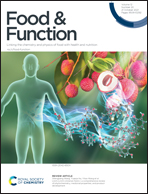The impact of the physical form of torularhodin on its metabolic fate in the gastrointestinal tract
Abstract
Torularhodin is a fungal carotenoid with multiple health benefits. However, the relationship between its physical form and metabolic fate in the gastrointestinal tract (GIT), which is essential to its bioavailability and health efficacy, has rarely been studied. Thus, physical forms of torularhodin including nanoemulsion powder (T-EP), capsules of the T-EP by alginate (T-EPA), and solution in MCT oil (T-oil) were used in the study. T-EP was produced through OSA-starch-mediated torularhodin emulsification and spray drying whereas the T-EPA was alginate-based capsules of the T-EP particles that were entrapped in the network structure of the alginate matrix as observed by scanning electron microscopy (SEM). The oil digestibility in the simulated small intestine was decreased from T-EP (100%), T-oil (60%) to T-EPA (40%), and the bioaccessibilities were 27%, 15% and 12%, respectively. The in vivo study using mice revealed that the content of torularhodin gradually decreased along with the digestion time in both the stomach and small intestine while a significantly higher colonic accumulation was observed in T-EPA compared to T-oil and T-EP. In vitro fecal fermentation showed that propionate (32 mM) was the predominant metabolite produced by torularhodin in the physical form of T-EPA. Thus, the physical form of torularhodin is a significant contributing factor to its GIT metabolic fate, and a health outcome-oriented design of the physical form of torularhodin or other nutraceuticals is beneficial for the development of functional foods with enhanced health benefits.



 Please wait while we load your content...
Please wait while we load your content...